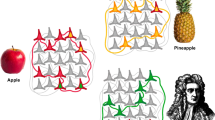Abstract
At present, the prevailing Connectionist methodology forrepresenting rules is toimplicitly embody rules in “neurally-wired” networks. That is, the methodology adopts the stance that rules must either be hard-wired or “trained into” neural structures, rather than represented via explicit symbolic structures. Even recent attempts to implementproduction systems within connectionist networks have assumed that condition-action rules (or rule schema) are to be embodied in thestructure of individual networks. Such networks must be grown or trained over a significant span of time. However, arguments are presented herein that humanssometimes follow rules which arevery rapidly assignedexplicit internal representations, and that humans possessgeneral mechanisms capable of interpreting and following such rules. In particular, arguments are presented that thespeed with which humans are able to follow rules ofnovel structure demonstrates the existence of general-purpose rule following mechanisms. It is further argued that the existence of general-purpose rule following mechanisms strongly indicates that explicit rule following is not anisolated phenomenon, but may well be a common and important aspect of cognition. The relationship of the foregoing conclusions to Smolensky's view of explicit rule following is also explored. The arguments presented here are pragmatic in nature, and are contrasted with thekind of arguments developed by Fodor and Pylyshyn in their recent, influential paper.
Similar content being viewed by others
References
Anderson, J. R. (1976),Language, Memory and Thought, Hillsdale, NJ: Lawrence Erlbaum Associates.
Ajjanagadde, V. & Shastri, L. (1989), ‘Efficient Inference with Multi-Place Predicates and Variables in a Connectionist System’, Proceedings of the Eleventh Annual Conference of the Cognitive Science Society, Ann Arbor, pp. 396–403.
Barnden, J. A. (1988), ‘The Right of Free Association: Relative-Position Encoding for Connectionist Data Structures’, Proceedings of the Tenth Annual Conference of the Cognitive Science Society, Montreal, pp. 503–509.
Clark, A. (1989),Microcognition: Philosophy, Cognitive Science, and Parallel Distributed Processing, Cambridge, MA: MIT Press.
Cottrell, G. W. & Tsung, F. (1989), ‘Learning Simple Arithmetic Procedures’, Proceedings of the Eleventh Annual Conference of the Cognitive Science Society, Ann Arbor, pp. 58–65.
Elman, J. L. (1989), ‘Structured Representations and Connectionist Models’, Proceedings of the Eleventh Annual Conference of the Cognitive Science Society, Ann Arbor, pp. 17–23.
Fodor, J. A. & Pylyshyn, Z.W. (1988), ‘Connectionism and Cognitive Architecture: A Critical Analysis’,Cognition 28, pp. 3–71.
Hadley, R. F. (1992), ‘Compositionality and Systematicity in Connectionist Language Learning’, Technical Report CSS-IS TR 92-03, Centre for Systems Science, Simon Fraser University, Burnaby, Canada.
Hadley, R. F. (1989), ‘A Default-Oriented Theory of Procedural Semantics’,Cognitive Science 13, pp. 107–138.
Kirsh, D. (1990), ‘When is Information Explicitly Represented’, inInformation, Language, and Cognition: Vancouver Studies in Cognitive Science, Vol. 1. Hanson, P. P., ed., Vancouver, BC: University of British Columbia Press.
Pinker, S. & Prince, A. (1988), ‘On Language and Connectionism: Analysis of a Parallel Distributed Processing Model of Language Acquisition’,Cognition 28, pp. 73–193.
Pylyshyn, Z. W. (1984),Computation and Cognition, Cambridge, MA: MIT Press.
Smolensky, P. (1987), ‘The Constituent Structure of Mental States: A Reply to Fodor and Pylyshyn’,Southern Journal of Philosophy 26, Supplement, pp. 137–160.
Smolensky, P. (1988), ‘On the Proper Treatment of Connectionism’,Behavioral and Brain Sciences 11, pp. 1–23.
St. John, M. F. & McClelland, J. L. (1990), ‘Learning and Applying Contextual Constraints in Sentence Comprehension’,Artificial Intelligence 46, pp. 217–257.
Touretzky, D. S. & Hinton, G. E. (1988), ‘A Distributed Connectionist Production System’,Cognitive Science 12, pp. 423–466.
van Gelder, T. (1990), ‘Compositionality: A Connectionist Variation on a Classical Theme’,Cognitive Science 14, pp. 355–384.
Author information
Authors and Affiliations
Rights and permissions
About this article
Cite this article
Hadley, R.F. Connectionism, explicit rules, and symbolic manipulation. Mind Mach 3, 183–200 (1993). https://doi.org/10.1007/BF00975531
Issue Date:
DOI: https://doi.org/10.1007/BF00975531




